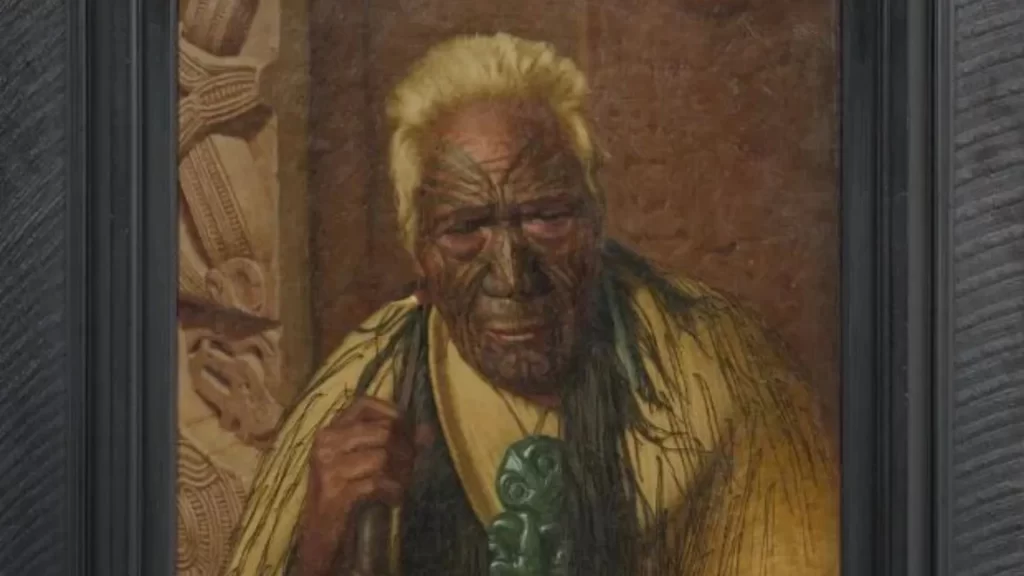Painting of Māori elder fetches record price in NZ auction
3 min read
An oil painting by renowned New Zealand artist Charles Frederick Goldie has set a new record for the highest price ever achieved for a work of art at auction in New Zealand. The painting, titled Thoughts of a Tohunga, was sold for NZ$3.75 million (about $2.2 million or £1.7 million) on Tuesday, making it the most valuable piece of art of its kind in the country’s history.
The portrait depicts Wharekauri Tahuna, a Māori elder and priest, believed to be one of the last men of his generation to have the traditional facial tattoo, or moko. This painting is particularly significant as it shows Tahuna wearing the hei-tiki, a Māori pendant worn as a symbol of high status. Painted in 1938, nine years before Goldie’s death in 1947, Thoughts of a Tohunga is widely regarded as one of his finest works by art critics. It was sold for the first time in 33 years, drawing interest from collectors and art enthusiasts alike.
Goldie’s legacy in New Zealand art is well established. During his lifetime, he became known for his intimate portraits of Māori subjects, particularly elderly individuals who wore traditional tattoos. His works have always been highly regarded, with New Zealanders having a strong connection to their history. According to Richard Thomson, the director of the International Art Centre, where the auction took place, portraits by Goldie have always been in demand. Since 2016, his auction house has sold 13 of Goldie’s paintings, with each fetching over a million New Zealand dollars.
Wharekauri Tahuna was one of Goldie’s favorite subjects and appeared in several of his paintings. He is depicted in this particular work in a dignified, thoughtful pose, a representation that aligns with Goldie’s respect for his subjects. Tahuna’s image, especially with his moko, serves as a visual reminder of Māori traditions and culture, which Goldie meticulously documented during a time when the Māori way of life was rapidly changing.
This record-breaking sale comes amid a backdrop of growing racial tensions in New Zealand. Recently, the government introduced a controversial bill that many Māori have criticized as an attack on their rights. The bill, which seeks to reinterpret the Treaty of Waitangi—New Zealand’s founding agreement between the Crown and Māori people—has sparked protests and widespread debate. Thousands of Māori and their supporters participated in a nine-day march last week, voicing opposition to the legislation. Although the bill passed its first reading in Parliament, it is not expected to progress to a second reading as the coalition partners of the Act Party, the political group sponsoring the bill, have indicated they will not support it.
Māori people, who make up about 18% of New Zealand’s population, continue to face significant disadvantages in terms of health, education, income, and incarceration rates. The life expectancy of Māori is, on average, seven years lower than that of non-Māori New Zealanders. These disparities highlight the ongoing challenges faced by Māori communities, making the record-breaking sale of Goldie’s painting particularly poignant.
Goldie’s portraits, including Thoughts of a Tohunga, are more than just representations of individual Māori figures—they are a reflection of a time and culture that has undergone significant transformation. In many ways, these artworks help preserve the history and heritage of the Māori people, providing a visual archive of their traditions and customs as they were in the late 19th and early 20th centuries.
While the sale of Goldie’s painting marks a moment of celebration for the art world, it also comes at a time of reflection for the nation. New Zealand’s complex relationship with its Māori population, particularly in light of the recent political developments, underscores the ongoing relevance of Māori culture and the need for continued dialogue and reconciliation.





